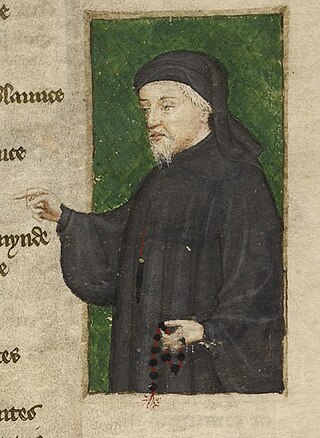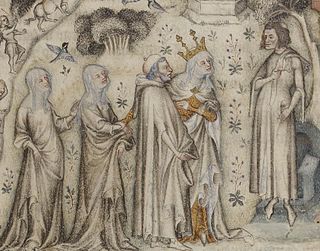Related Research Articles

Geoffrey Chaucer was an English poet,author,and civil servant best known for The Canterbury Tales. He has been called the "father of English literature",or,alternatively,the "father of English poetry". He was the first writer to be buried in what has since come to be called Poets' Corner,in Westminster Abbey. Chaucer also gained fame as a philosopher and astronomer,composing the scientific A Treatise on the Astrolabe for his 10-year-old son Lewis. He maintained a career in the civil service as a bureaucrat,courtier,diplomat,and member of parliament.

John Gower was an English poet,a contemporary of William Langland and the Pearl Poet,and a personal friend of Geoffrey Chaucer. He is remembered primarily for three major works—the Mirour de l'Omme,Vox Clamantis,and Confessio Amantis—three long poems written in French,Latin,and English respectively,which are united by common moral and political themes.

Guillaume de Machaut was a French composer and poet who was the central figure of the ars nova style in late medieval music. His dominance of the genre is such that modern musicologists use his death to separate the ars nova from the subsequent ars subtilior movement. Regarded as the most significant French composer and poet of the 14th century,he is often seen as the century's leading European composer.
Eustache Deschamps was a French poet,byname Morel,in French "Nightshade".
The ballade is a form of medieval and Renaissance French poetry as well as the corresponding musical chanson form. It was one of the three formes fixes and one of the verse forms in France most commonly set to music between the late 13th and the 15th centuries.

Jehan de Lescurel was a composer-poet of late medieval music. Jehan's extensive surviving oeuvre is an important and rare examples of the formes fixes before the time of Guillaume de Machaut;it consists of 34 works:20 ballades,12 rondeaus and two long narrative poems,diz entés. All but one of his compositions is monophonic,representing the end of the trouvère tradition and the beginning of the polyphonic ars nova style centered around the formes fixes.

F. Andrieu was a French composer in the ars nova style of late medieval music. Nothing is known for certain about him except that he wrote Armes,amours/O flour des flours,a double ballade déploration,for the death of Guillaume de Machaut in 1377. The work has been widely praised and analyzed;it is notable for being one of two extant medieval double ballades for four voices,the only known contemporary musical setting of Eustache Deschamps and the earliest representative of the longstanding medieval and Renaissance lamentation tradition between composers.

Grimace was a French composer-poet in the ars nova style of late medieval music. Virtually nothing is known about Grimace's life other than speculative information based on the circumstances and content of his five surviving compositions of formes fixes;three ballades,a virelai and rondeau. His best known and most often performed work in modern-times is the virelai and proto-battaglia:A l’arme A l’arme.
Sylvia Huot is a professor of Medieval French Literature at the University of Cambridge and fellow of Pembroke College. She is the author of several internationally renowned books on Medieval French Literature and the leading expert on the manuscripts of Roman de la Rose,having published extensively on its iconography.
Marie Edith Borroff was an American poet,translator,and the Sterling Professor of English emerita at Yale University.
Guillaume de Dole is an Old French narrative romance by Jean Renart. Composed in the early 13th century,the poem is 5,656 lines long and is especially notable for the large number of chansons it contains,and for its active female protagonist. The romance incorporates forty-six chansons;it is the first extant example in French literature of a text that combines narrative and lyric. Its form was quickly imitated,by authors such as Gerbert de Montreuil,and by the end of the 13th century had become canonical.
Laura Howes is an American scholar of Middle English literature. She is the author of Chaucer's Gardens and the Language of Convention (1998) and the editor,with Marie Borroff,of the Norton Critical Edition of Sir Gawain and the Green Knight (2010). Howes received her B.A. from Cornell University and her M.A. and Ph.D. from Columbia University,and is Professor of English at the University of Tennessee.
Henry Ansgar Kelly is distinguished research professor of English at the University of California,Los Angeles.
P. des Molins,probably Pierre des Molins,was a French composer-poet in the ars nova style of late medieval music. His two surviving compositions –the ballade De ce que fol pensé and rondeau Amis,tout dous vis –were tremendously popular as they are among the most transmitted pieces of fourteenth-century music. The ballade is found in 12 medieval manuscript sources and featured in a c. 1420 tapestry;the rondeau is found in 8 sources and referenced by the Italian poet Simone de' Prodenzani. Along with Grimace,Jehan Vaillant and F. Andrieu,Molins was one of the post-Guillaume de Machaut generation whose music shows few distinctly ars subtilior features,leading scholars to recognize Molins's work as closer to the ars nova style of Machaut.
Roberta Frank is an American philologist specializing in Old English and Old Norse language and literature. She is the Marie Borroff Professor Emeritus of English at Yale University.
Alastair J. Minnis is a Northern Irish literary critic and historian of ideas who has written extensively about medieval literature,and contributed substantially to the study of late-medieval theology and philosophy. Having gained a first-class B.A. degree at the Queen's University of Belfast,he matriculated at Keble College,Oxford as a visiting graduate student,where he completed work on his Belfast Ph.D.,having been mentored by M.B. Parkes and Beryl Smalley. Following appointments at the Queen's University of Belfast and Bristol University,he was appointed Professor of Medieval Literature at the University of York;also Director of the Centre for Medieval Studies and later Head of English &Related Literature. From 2003 to 2006,he was a Humanities Distinguished Professor at Ohio State University,Columbus,from where he moved to Yale University. In 2008,he was named Douglas Tracy Smith Professor of English at Yale.
Elizabeth Eva Leach is a British musicologist and music theorist who specializes in medieval music,especially that of the fourteenth century. Much of her scholarship concerns the life and work of Guillaume de Machaut.
Sebastian Sobecki is a medievalist specialising in English literature,history,and manuscript studies.

Ethelbert Talbot Donaldson was a scholar of medieval English literature,known for his 1966 translation of Beowulf and his writings on Chaucer's poetry.
"Maiden in the mor lay" or "The Maid of the Moor" is a Middle English lyric of the early 14th century,set to a melody which is now lost. The literary historian Richard L. Greene called it "one of the most haunting lyrics of all the Middle Ages",and Edith Sitwell thought it "a miracle of poetry". It is a notoriously enigmatic poem,perhaps devotional,perhaps secular,which depicts a maiden in the wilderness who lives on flowers and spring-water. Critics are divided in their interpretation of her:she may be the Virgin Mary,Mary Magdalene,a water-sprite,or an ordinary human girl. The 14th-century bishop Richard de Ledrede's dissatisfaction with this song led to an alternative lyric for it being written,a Latin religious poem,Peperit virgo.
References
- ↑ "Ardis Butterfield | Department of Music". yalemusic.yale.edu. Yale University. Retrieved 17 July 2017.
- ↑ "Ardis Butterfield | English". english.yale.edu. Retrieved 2019-05-11.
- ↑ Butterfield, Ardis Ruth Teasdale (1988). Interpolated lyric in medieval narrative poetry (Ph.D. thesis). University of Cambridge.
- 1 2 3 4 "Ardis Butterfield | English". english.yale.edu. Yale University.
- ↑ "Medieval Song Network: About Us". medievalsongnetwork.org. Retrieved February 23, 2019.
- ↑ "Faculty of English". www.english.cam.ac.uk. Retrieved 2019-04-25.
- 1 2 "Ardis Butterfield appointed the Marie Borroff Professor of English". August 6, 2018. Retrieved February 23, 2019.
- ↑ Cooper, Helen (7 October 2010). "Writing French in English". London Review of Books. pp. 9–11. Retrieved 17 July 2017.
- ↑ Fein, David A. (27 October 2010). "The Familiar Enemy: Chaucer, Language, and Nation in the Hundred Years War (review)". French Studies: A Quarterly Review. 64 (4): 476–477. doi:10.1093/fs/knq162. ISSN 1468-2931 . Retrieved 17 July 2017.
- ↑ Johnston, Andrew James (2012). "Ardis Butterfield. The Familiar Enemy: Chaucer, Language and Nation in the Hundred Years War". Anglia: Zeitschrift für englische Philologie. 130 (2). doi:10.1515/ang-2012-0049. ISSN 1865-8938. S2CID 162321411.
- ↑ Rigby, S. H. (1 August 2011). "The Familiar Enemy: Chaucer, Language and Nation in the Hundred Years War, by Ardis Butterfield". The English Historical Review. CXXVI (521): 916–917. doi:10.1093/ehr/cer109. ISSN 0013-8266 . Retrieved 17 July 2017.
- ↑ Peyton III, Henry H. (1 April 2015). "Poetry and Music in Medieval France: From Jean Renart to Guillaume de Machaut by Ardis Butterfield (review)". Arthuriana. 14 (3): 96–97. doi:10.1353/art.2004.0078. ISSN 1934-1539. S2CID 161393012.
- ↑ Steel, Matthew (1 January 2005). "05.01.33, Butterfield, Poetry and Music in Medieval France". The Medieval Review. ISSN 1096-746X . Retrieved 17 July 2017.
- ↑ Aubrey, Elizabeth (December 2005). "Poetry and Music in Medieval France: From Jean Renart to Guillaume de Machaut , by Ardis Butterfield . Cambridge Studies in Medieval Literature 49. Cambridge: Cambridge University Press, 2002. xx, 375 pp". Journal of the American Musicological Society. 58 (3): 704–710. doi:10.1525/jams.2005.58.3.704. ISSN 0003-0139.